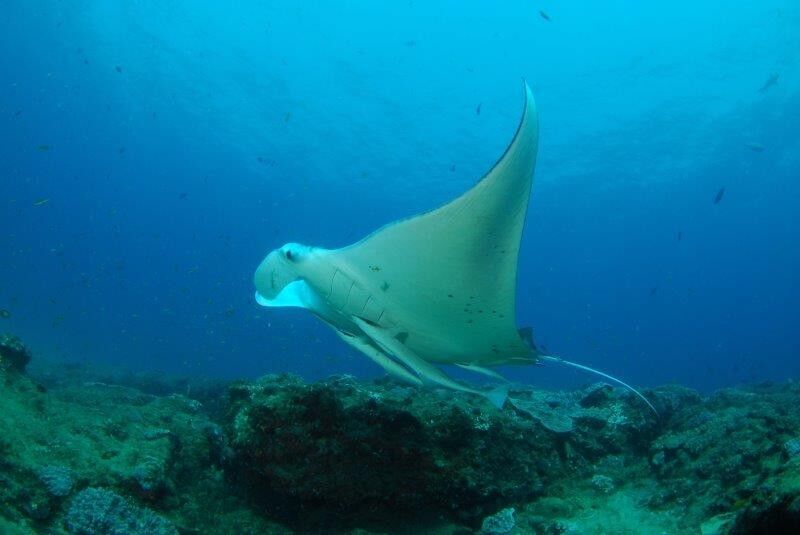South Africa’s Diverse Manta Ray Discoveries Could Boost KZN Tourism
Written by: Olivia Jones Communications Save to Instapaper
Unveiling South Africa’s Giant Rays: A Call for Conservation
While South Africa is renowned for its Big 5, few realise the country is also home to the world’s largest rays: manta rays. These intelligent filter feeders, which sustain themselves on zooplankton, are essential to maintaining ocean health. Beyond their ecological significance, manta rays have the potential to boost tourism revenue, yet they face growing threats from unsustainable fishing practices and human activity.
A nationwide collaborative study by marine biologists has revealed fascinating insights into South Africa’s manta rays, shedding light on these gentle giants and their role in the ecosystem.
Discovering South Africa’s Manta Rays
“Most South Africans don’t realise they can see manta rays without leaving the country,” says Dr Michelle Carpenter, a collaborator with the Marine Megafauna Foundation (MMF), Clansthal Conservancy, and Manta Trust. South Africa is home to two species:
- Reef manta ray (Mobula alfredi)
- Oceanic manta ray (Mobula birostris), the largest ray in the world, with a wingspan of up to 8 metres.
Sadly, human activities have caused a significant population decline, making South Africa’s mantas the most threatened population globally. Both species are listed as endangered on the IUCN Red List. Threats include:
- Trawling
- Tuna purse seine nets
- Gill nets in Mozambique
- Shark nets in South Africa
- Seismic testing by oil companies
Key Findings of the Manta Study
The study, conducted by a team of marine biologists, uncovered several unique characteristics of South Africa’s mantas:
- Reef mantas exhibit high mobility.
- Rare melanistic oceanic mantas (entirely black) were observed.
- Newly identified feeding aggregations and potential baby manta nurseries were found.
Discoveries at iSimangaliso Wetland Park
iSimangaliso Wetland Park, a marine sanctuary in northern KwaZulu-Natal (KZN), emerged as a critical habitat for manta rays. The park, protected from fishing and recreational diving for over 50 years, accounts for 89% of South Africa’s reef manta sightings.
“This aggregation area within a restricted-access sanctuary is a haven amidst threats along the coastline,” explains Nakia Cullain of the Marine Megafauna Foundation. In iSimangaliso, mantas feed and have parasites removed by cleaner fish, demonstrating the sanctuary’s vital role.
iSimangaliso is one of several Mission Blue Hope Spots along South Africa’s coast, joining others like Aliwal Shoal and Cape Town. These areas showcase the effectiveness of marine protection, offering a model for regions like Mozambique that lack extensive marine safeguards.
Manta Ray Connectivity and Movements
Research revealed significant connectivity between South Africa and Mozambique, highlighting the need for cross-border conservation strategies. Key findings include:
- A manta travelled 1,305 km multiple times between Zavora, Mozambique, and iSimangaliso.
- Another covered 600 km from Pondoland MPA to iSimangaliso.
- Juveniles sighted in one region were later observed as adults in another.
“These movements are likely driven by seasonal zooplankton availability,” says Dr Carpenter, who notes that rising ocean temperatures from climate change may be affecting manta movements.
Rare Melanistic Manta Rays
Oceanic mantas are rare in South African waters, with sightings mainly in Ballito, Aliwal Shoal MPA, and Pondoland MPA. Among the most exciting discoveries were rare melanistic mantas, first observed in Aliwal Shoal (February 2020) and Ballito (November 2021).
“It was not previously known that melanistic oceanic mantas inhabited these waters,” explains Dr Carpenter. While genetic studies suggest no distinct population groupings, localised differences in melanism may be influenced by regional groupings and long-distance travel.
“We love that these melanistic mantas contribute to South Africa’s beautiful ‘RAYnbow Nation!’”
Protecting South Africa’s Myste-RAY-ous Giants
Despite their ecological importance, manta rays face threats from fishing, seismic testing, and climate change. Collaborative research efforts and marine sanctuaries like iSimangaliso Wetland Park offer hope for their future.
Dr Carpenter concludes:“There is no shortage of work to do with sharks and rays along South Africa’s coastline. I encourage South Africans and international students eager to make a difference to join us. It’s hard work but immensely rewarding.”
By supporting conservation initiatives and protecting these gentle giants, South Africa can ensure its manta rays thrive for generations to come.
Submitted on behalf of
- Company: Olivia Jones Communications
- Contact #: 0824813288
- Website
Get new press articles by email
Latest from
- Northlands Primary Smooth Sailors made history at the Unearthed First LEGO League nationals this weekend and will represent South Africa in South Korea next year.
- How Community-Driven Initiatives are Reinvigorating the KZN Mid-South Coast
- Renishaw Hills Welcomes Wheelchair Advocate Muzi Fodo on His Fundraising Journey
- Join Crocworld to Celebrate Henry’s 125th Birthday in Style
- Chris Bertish to Launch New Book Super Stoked! at The Pipe in Scottburgh
- Sapphire Coast Tourism Announces Exciting Festive Season Programme for 2025
- How Retirement Estates on KZN Mid-South Coast Provide Great ‘Return on Lifestyle’
- Joekels Celebrates 31 Years with Prestigious Shoprite Supplier of the Year 2025 Award
- Indoor Family Experience, Total Ninja Interactive, Launches in Joburg
- Beloved SA Chefs Share Their Top Tips for Hosting Christmas on a Budget
- Concentrix Champions Women’s Empowerment at Women of Worth Launch
- Celebrate the Festive Season and Henry’s 125th Birthday at Crocworld Conservation Centre!
- Meet the International Outdoor Educator Heading Up WildED Holiday Camp This December!
- South Africa’s Future Scientists and Designers Shine at Laager Rooibos Competitions
- Dietitian Explains How Chamomile Tea Can Help Improve Sleep
The Pulse Latest Articles
- Education Is The Frontline Of Inequality, Business Must Show Up (December 11, 2025)
- When The Purple Profile Pictures Fade, The Real Work Begins (December 11, 2025)
- Dear Santa, Please Skip The Socks This Year (December 10, 2025)
- Brandtech+ Has 100 Global Creative Roles For South African Talent (December 9, 2025)
- The Woman Behind Bertie: Michelle’s Journey To Cape Town’s Beloved Mobile Café (December 9, 2025)
